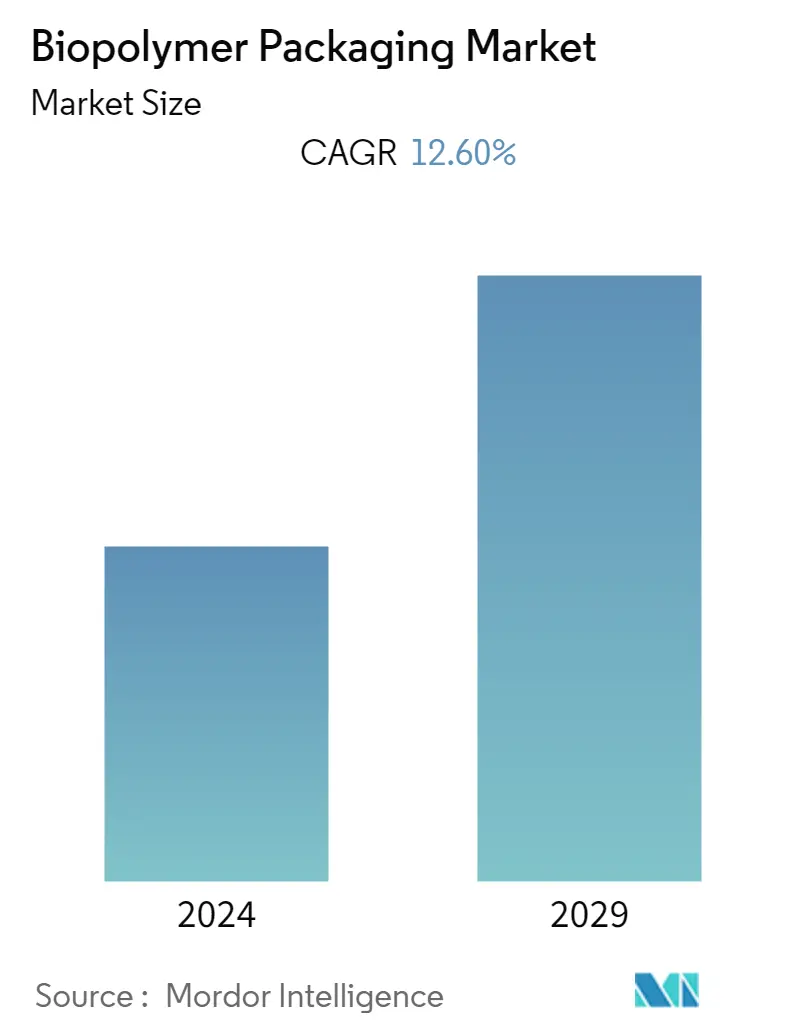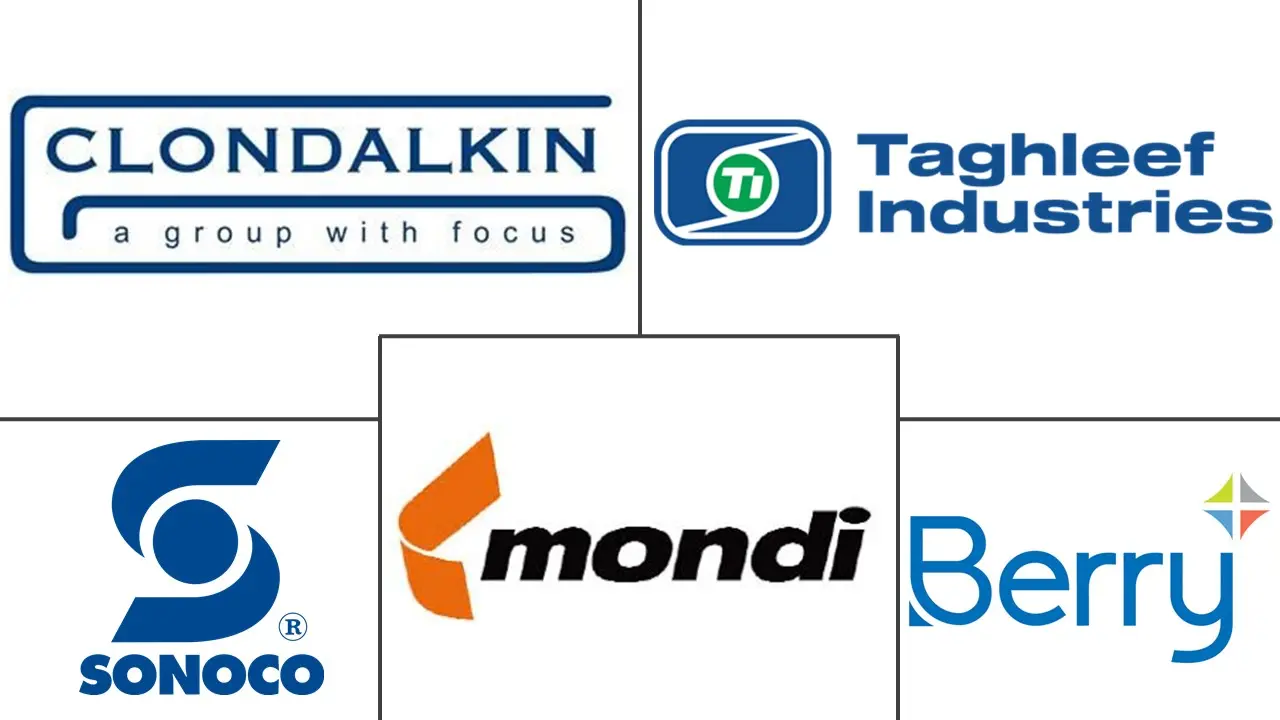Market Size of Biopolymer Packaging Industry

| Study Period | 2019 - 2029 |
| Base Year For Estimation | 2023 |
| CAGR | 12.60 % |
| Fastest Growing Market | Asia Pacific |
| Largest Market | North America |
| Market Concentration | High |
Major Players
*Disclaimer: Major Players sorted in no particular order |
Biopolymer Packaging Market Analysis
The biopolymer packaging market is expected to grow at a CAGR of 12.6% over the forecast period (2021 - 2026). Biopolymers refer to naturally occurring polymers, primarily from renewable sources, such as plants and animals, which help manufacture plastics. Furthermore, the companies in the market studied are focusing on increasing the production capabilities of biopolymers.
- Multiple factors such as the volatility of oil prices, the globally increasing interest in renewable resources, the growing concerns regarding the greenhouse gas emissions, and the current emphasis on waste management have created an increasing interest in biopolymers and bioplastics.
- With the improved biopolymer processing technologies, vendors in the market have been enabled with better control of macromolecular structures that have allowed new generations of commodity polymers that challenge the expensive specialty polymers.
- The development of newer materials, particularly the innovative biopolymer formulations, is helping in addressing various requirements with other packaging functions such as food preservation and protection towards consumers. The use of biocomposites for active food packaging is one of the most-studied approaches in the past few years for materials in contact with food. Applications of these innovative biocomposites are helping to provide new food packaging materials that have improved mechanical, barrier, antioxidant, and antimicrobial properties
- Further, the increasing concerns on food wastage are preventing the complete replacement of plastics as they remain the best solution to increase the shelf life of products. According to the Food & Agriculture Organization, 1.3 billion tons of food worldwide is wasted annually. This has led to several innovations where biopolymer plastics are being developed to increase shelf life without compromising on sustainability concerns.
- To truly capture the potential for biodegradable plastic packaging, multiple cities across the globe need to have an adequate composting and collection infrastructure to support their usage. Currently, very few municipalities across the globe have such infrastructure. However, with the increasing awareness, investment, and ban on single-use plastic, this is likely to ascend, creating an ample amount of opportunities for the existing and new market players.
- Also, the immediate impact on the consumer's concerns about the viral exposure of the Corona Virus and the questions around the virus' ability to survive on surfaces are expected to fuel a much longer-lasting demand for new packaging and materials that exhibit antiviral and antibacterial properties.
- Moreover, researches are being done in antibacterial and antiviral polymers and biopolymers for packaging. Enhanced active drug materials that are efficient and exhibit low toxicity are being studied. The demand for such materials in the day-to-day consumer products is expected to rise significantly post-COVID-19 era, as consumers are likely to maintain concerns and habits learned during this challenging period.
Biopolymer Packaging Industry Segmentation
Biopolymers are polymers that are produced by living organisms. Some of the biopolymers are proteins, lipids, DNA, RNA, and carbohydrates. The market is segmented by Non-biodegradable (PET, PA, PTT, and Other Non-biodegradable Materials), Biodegradable (PLA, PBAT, Starch Blends, and Other Biodegradable Materials), End User (Food and Beverages, Retail, Healthcare, and Automotive), and Geography.
| Material Type | ||||||
| ||||||
|
| End-user Industry | |
| Food and Beverages | |
| Retail | |
| Healthcare | |
| Personal Care/Homecare | |
| Other End-user Industries |
| Geography | |
| North America | |
| Europe | |
| Asia Pacific | |
| Latin America | |
| Middle East and Africa |
Biopolymer Packaging Market Size Summary
The biopolymer packaging market is poised for significant growth, driven by the increasing demand for sustainable and eco-friendly packaging solutions. Biopolymers, derived from renewable sources like plants and animals, are gaining traction due to their potential to replace conventional plastics, especially in the context of rising oil prices and environmental concerns. The market is witnessing advancements in processing technologies that enhance the properties of biopolymers, making them viable alternatives to traditional materials. Innovations in biopolymer formulations are addressing various packaging needs, such as food preservation and protection, by offering improved mechanical, barrier, antioxidant, and antimicrobial properties. The growing emphasis on waste management and the reduction of greenhouse gas emissions further bolster the market's expansion, as companies strive to meet regulatory requirements and consumer preferences for sustainable products.
The Asia-Pacific region stands out as a major consumer and producer of biopolymers, with countries like China and India leading the charge due to increasing environmental awareness and government regulations promoting sustainable packaging. The region's burgeoning food and beverage sector, coupled with the rise of organized retail, is driving the demand for innovative packaging solutions. The market is moderately consolidated, with key players like Mondi Group and Taghleef Industries Inc. leveraging their competitive advantages through continuous product innovation and strategic partnerships. As global awareness and investment in biodegradable plastics grow, the biopolymer packaging market is expected to see substantial opportunities, particularly with the ongoing shift towards compostable and recyclable materials in response to regulatory pressures and consumer demand.
Biopolymer Packaging Market Size - Table of Contents
-
1. MARKET DYNAMICS
-
1.1 Market Overview
-
1.2 Introduction to Market Drivers and Restraints
-
1.3 Market Drivers
-
1.3.1 The Growing Government Regulations for Bio-based Packaging
-
1.3.2 Increasing Awareness for Human Well Being and Eco-friendly Products
-
-
1.4 Market Restraints
-
1.4.1 Performance Issues with Bio-based Materials
-
1.4.2 High Cost of Bio-packaging Materials
-
-
1.5 Value Chain Analysis
-
1.6 Industry Attractiveness - Porter's Five Forces Analysis
-
1.6.1 Threat of New Entrants
-
1.6.2 Bargaining Power of Buyers/Consumers
-
1.6.3 Bargaining Power of Suppliers
-
1.6.4 Threat of Substitute Products
-
1.6.5 Intensity of Competitive Rivalry
-
-
1.7 Assessment of COVID-19 impact on the Industry
-
-
2. MARKET SEGMENTATION
-
2.1 Material Type
-
2.1.1 Non-biodegradable
-
2.1.1.1 PET
-
2.1.1.2 PA
-
2.1.1.3 PTT
-
2.1.1.4 Other Material Types
-
-
2.1.2 Biodegradability
-
2.1.2.1 PLA
-
2.1.2.2 Starch Blends
-
2.1.2.3 PBAT
-
2.1.2.4 Other Biodegradability Types
-
-
-
2.2 End-user Industry
-
2.2.1 Food and Beverages
-
2.2.2 Retail
-
2.2.3 Healthcare
-
2.2.4 Personal Care/Homecare
-
2.2.5 Other End-user Industries
-
-
2.3 Geography
-
2.3.1 North America
-
2.3.2 Europe
-
2.3.3 Asia Pacific
-
2.3.4 Latin America
-
2.3.5 Middle East and Africa
-
-
Biopolymer Packaging Market Size FAQs
What is the current Biopolymer Packaging Market size?
The Biopolymer Packaging Market is projected to register a CAGR of 12.60% during the forecast period (2024-2029)
Who are the key players in Biopolymer Packaging Market?
Mondi Group, Taghleef Industries Inc., Clondalkin Group Holdings BV, Sonoco Products Company and Berry Plastics Group Inc. are the major companies operating in the Biopolymer Packaging Market.

